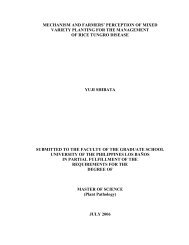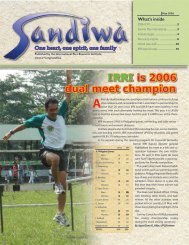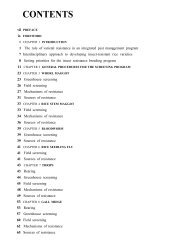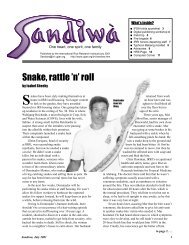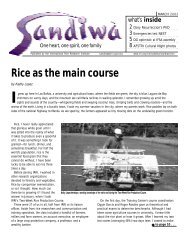Untitled - International Rice Research Institute
Untitled - International Rice Research Institute
Untitled - International Rice Research Institute
You also want an ePaper? Increase the reach of your titles
YUMPU automatically turns print PDFs into web optimized ePapers that Google loves.
They are feathery to slightly fluffy, zonated with<br />
even to slightly uneven margins, and alternating olive<br />
yellow and dark olive with 5-mm light yellow margins.<br />
On the reverse side of the agar plate, the colony<br />
appears azonated to slightly zonated, black, and becomes<br />
dark greenish gray to olive black toward the<br />
margin.<br />
Colonies on MEA at ART (28–30 °C) grow very<br />
slowly and attain a 2.29-cm diam in 5 d. Colonies are<br />
scanty with fluffy aerial mycelia, azonated with uneven<br />
margins, and olive gray with grayish yellow<br />
aerial mycelia. The colony appears azonated and<br />
olive black on the reverse side of the agar plate. At<br />
21 °C under alternating 12-h NUV light and 12-h<br />
darkness, colonies are restricted in growth and attain<br />
a 1.71-cm diam in 5 d. They are azonated with<br />
crenate margins, velvety, and olive black with white<br />
to dark olive mycelial tufts. The colony appears zonated<br />
and olive black to black on the reverse side of<br />
the agar plate. At 28 °C under alternating 12-h fluorescent<br />
light and 12-h darkness, colonies are restricted<br />
in growth and attain a 1.71-cm diam in 5 d.<br />
They are azonated with crenate margins, velvety<br />
with slightly fluffy centers, and dark greenish gray to<br />
olive black. The colony on the reverse side of the<br />
agar plate appears azonated and black.<br />
Cercospora janseana (Racib.) Const.<br />
syn. Cercospora oryzae Miyake<br />
teleomorph: Sphaerulina oryzina Hara<br />
Disease caused: narrow brown leaf spot<br />
a. Symptoms<br />
Short, linear, brown lesions most common on<br />
leaves but also occur on leaf sheaths, pedicels,<br />
and glumes.<br />
b. Occurrence/distribution<br />
The disease has worldwide distribution (Fig. 14).<br />
c. Disease history<br />
The disease was first observed in North America<br />
before 1910 but its detailed description was re-<br />
Fig. 14. Occurrence of narrow brown leaf spot (Ou 1985, Agarwal and Mathur 1988, EPPO 1997).<br />
21



